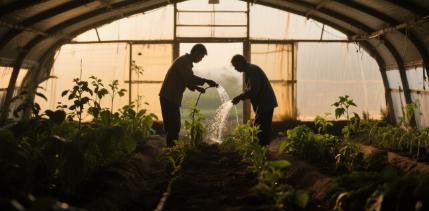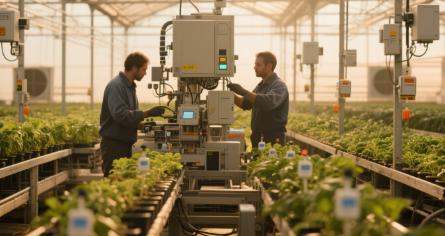In today’s evolving agricultural landscape, the word “greenhouse” can mean very different things. From high-tech facilities with automated systems to simple structures covered in plastic film, greenhouse types vary widely in their design, performance, and purpose.
If you’re considering investing in one, a big question arises: should you choose a traditional greenhouse or go for a climate-controlled one? The answer depends on your goals, your crops, your location, and your budget.
Let’s break down the differences and help you decide which greenhouse model fits your needs best.
1. What Defines a Traditional Greenhouse?
Traditional greenhouses are usually simple structures made of glass, polycarbonate panels, or plastic film. They rely heavily on natural sunlight and ventilation, and in most cases, the interior environment is not actively controlled by machines or software.
Common features include:
Basic ventilation through windows or roof openings
Manual temperature regulation (shade nets or physical covers)
Limited insulation
Seasonal use (often shut down in winter or peak summer)
Traditional greenhouses are especially common in small-scale farms or regions with moderate, stable climates.
2. What Is a Climate-Controlled Greenhouse?
A climate-controlled greenhouse, on the other hand, uses technology to manage environmental factors like temperature, humidity, light, and CO₂ levels. These greenhouses are engineered to grow crops year-round—even in extreme weather conditions.
Typical systems include:
Heating and cooling equipment (heat pumps, fans, wet walls)
Automated irrigation and fertigation
Sensors and software for real-time climate adjustment
Insulated walls and roofing for energy efficiency
Supplemental lighting for low-light seasons
Farms that produce high-value crops or operate in challenging climates often rely on this advanced approach.

3. Cost Comparison: Initial Investment and Maintenance
Traditional Greenhouse:
Lower construction cost
Basic materials and manual systems
Fewer ongoing technical expenses
Maintenance involves simple repairs and seasonal adjustments
Climate-Controlled Greenhouse:
Higher upfront investment
Expensive equipment (HVAC, automation, LED lighting)
Ongoing operational costs (electricity, system upkeep)
Requires technical knowledge or external service support
If you’re growing for local markets or home use, traditional greenhouses offer a cost-effective entry point. But if you’re scaling for commercial yield and consistent year-round output, the return on a climate-controlled greenhouse justifies the higher cost over time.

4. Environmental Control and Crop Performance
This is where climate-controlled greenhouses shine.
They allow precise control over:
Temperature: Protect crops from heatwaves or frost
Humidity: Prevent mold, improve pollination
Light exposure: Ensure steady growth during low-sunlight months
CO₂ levels: Enhance photosynthesis and crop growth speed
In contrast, traditional greenhouses depend on external conditions. A sudden cold front, cloudy week, or drought can impact yield and crop quality significantly.
For delicate crops like strawberries, herbs, or leafy greens, where consistency matters, climate control can mean the difference between profit and loss.
5. Crop Suitability: What Grows Best Where?
Traditional Greenhouses:
Hardy crops like tomatoes, cucumbers, beans, flowers
Regions with mild seasonal variation
Ideal for growing in spring and fall
Climate-Controlled Greenhouses:
High-value, sensitive crops like blueberries, lettuce, strawberries
Areas with extreme heat, cold, or humidity
Year-round production and fast-growing cycles
If you're in a region with long, harsh winters or high summer temperatures, relying solely on natural climate makes it risky to grow premium crops. Climate-controlled systems protect your harvest from unpredictability.
6. Labor and Management Requirements
Traditional greenhouses are easier to manage without specialized training. They suit family farms or part-time growers who can tend plants manually and make seasonal adjustments.
Climate-controlled greenhouses, however, need a more technical approach. Staff must monitor data, manage software platforms, and troubleshoot equipment.
That said, automation can reduce daily workload significantly. Once systems are set up correctly, fewer people are needed to manage a larger growing area.
7. Market Strategy and Profit Potential
Your business model should guide your decision.
Traditional Greenhouses: Great for local farmers markets, seasonal produce, or low-margin crops.
Climate-Controlled Greenhouses: Ideal for export markets, supermarkets, or businesses aiming for year-round supply and brand reputation.
For example, in some regions, Chengfei Greenhouse has supported farmers switching to climate-controlled models to grow export-grade peppers and tomatoes. These farms now produce over 180 tons of fresh vegetables annually and supply regional chains with guaranteed quality—regardless of the season.
8. Sustainability and Energy Use
Traditional greenhouses score well on sustainability because they use fewer machines and consume less electricity. But they may waste water or require more pesticide use due to less control over growing conditions.
Climate-controlled greenhouses consume more energy, but that’s changing with new technologies:
Solar panels and geothermal energy systems
Closed-loop irrigation and rainwater collection
AI-driven climate optimization to reduce waste
In the long run, many climate-controlled setups can become more water-efficient and climate-resilient than traditional models.
Ultimately, your choice depends on your budget, climate, target market, and management capacity. Some growers even use a hybrid approach—starting with traditional greenhouses and gradually upgrading to controlled systems.
Post time: Jul-20-2025







 Click to Chat
Click to Chat